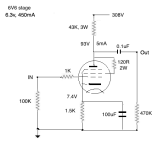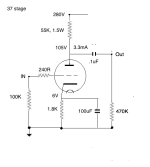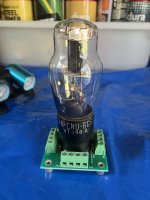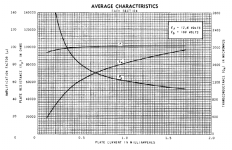Follow up on the 6V6 in triode. I used the 6P6S version because I only had those. With the same anode and cathode resistors I got 5mA of current. The sound is good - competitive with the others tested. So this goes into the mix as well. And easily available plus a gain of around 9 like the 37. Pin 4 on the 6J5 and 6P5GT isn't connected, so leaving the 100R resistor on it connecting G2 and anode on the 6V6 works OK.
It really is a toss-up between using an octal socket and a UX5. In terms of tube availability the octal wins hands down, though 6P5G/GT is scarce now.
I'll have to do some extended listening between the 37 and the 6V6 in triode.

It really is a toss-up between using an octal socket and a UX5. In terms of tube availability the octal wins hands down, though 6P5G/GT is scarce now.
I'll have to do some extended listening between the 37 and the 6V6 in triode.

Perhaps the 6G6-G (CV1926, or VT-198A) might be a contender among the octal-based triode-connected pentodes?
Ah - the 6G6G. Yes, could be. Thanks for that. Do you know it yourself?
I was just looking at the data for the 6F6G. Are there any other similar octal pentodes/tetrodes that could be used in triode?
I was just looking at the data for the 6F6G. Are there any other similar octal pentodes/tetrodes that could be used in triode?
Yes - I've had it on the bench, cathode biased. It is electronically well-behaved as a low-gain voltage amplifier and sounded just fine. It has the cylindrical anode that you have noted on other valves you have tested.Ah - the 6G6G. Yes, could be. Thanks for that. Do you know it yourself?
Octals: the 6C5 is equal to the triode-connected 6J7 which, in turn, is identical to the 6-pin type 77 (nice history here: https://nzvrshome.files.wordpress.com/2018/10/the-6j7-fraternity.pdf). I have used triode-connected 6J7s as voltage amplifiers where they do good service (including in 1930s/1940s Fender guitar amps). There is also the octal 6K6G which is equivalent of the 6-pin type 41 - I have not used either.I was just looking at the data for the 6F6G. Are there any other similar octal pentodes/tetrodes that could be used in triode?
5-pin sockets: if you're playing with the 37 and 76, the flat anode, direct-heated 6A4/LA might interest you. Triode connected with Vak=135V, Vgk=-10V and ia=15mA it has mu=6, gm=2.4mS, rp=2500 Ohms. I have used it choke-loaded, very linear and good-sounding. I have also contemplated the 5-pin type 55 indirectly-heated triode but have not tried it.
6-pin sockets: in addition to types 77 and 41 cited above, 6-pin types 42 and 2A5 are electrically identical to the octal 6F6G and all have a cylindrical anode. The caveat is that I have only used the 42=2A5 as a power pentode and not as a triode-connected voltage amplifier and can't vouch for it in the latter role. Casting the net wider, types 55 and 85 are duplex-diode+triodes that offer mu=8.3 which may suit you - I've not used these.
7-pin sockets: RCA cited the type 59 as very close in characteristics to the 42/2A5/6F6G, with the 7th pin bringing the suppressor grid out to the socket.
Attachments
Thanks for that, Bondini. I'll try the 6G6 because it's available and cheap.
On more extended listening I have a preference for the true triodes - 37, 76 and 6P5GT - over the pentodes/tetrodes in triode like 6V6, though I haven't heard all the possible ones with octal or UX5 bases.
On more extended listening I have a preference for the true triodes - 37, 76 and 6P5GT - over the pentodes/tetrodes in triode like 6V6, though I haven't heard all the possible ones with octal or UX5 bases.
I'm now using the 37 and optimising it. Better resisters in anode and cathode. The sound is becoming very good - getting closer to my 26 stage.
I've been reading posts on the 37/76/27 and there are complaints about soft bass frequencies. This is the only obvious flaw I have. I experienced the same kind of thing with the 26 and the bass tightened up when I used a larger value anode resistor. I ended up with around 5x the anode resistance, i.e. 39K. The anode resistance of the 37 at an anode voltage of around 100V is about 11K, so that points to an anode resistor around 55K or as close as possible. That brings the current to around 3.3mA. We'll see if this tightens up the bass. Otherwise I'm very pleased with this.

I've been reading posts on the 37/76/27 and there are complaints about soft bass frequencies. This is the only obvious flaw I have. I experienced the same kind of thing with the 26 and the bass tightened up when I used a larger value anode resistor. I ended up with around 5x the anode resistance, i.e. 39K. The anode resistance of the 37 at an anode voltage of around 100V is about 11K, so that points to an anode resistor around 55K or as close as possible. That brings the current to around 3.3mA. We'll see if this tightens up the bass. Otherwise I'm very pleased with this.

Whichever you choose, 5-pin or octal socket tubes, you can always have the option of using 5-pin to 8-pin or 8-pin to 5pin adapters. You have the best of both worlds. Once you are committed to one type then change to the appropriate socket for permanent use.
Personally I would stick with 6J5 as it's the most available and flexible. I would like to find some mesh round plate 37 tubes as I heard good sounds from mesh plate WE 262 tubes but those are going for crazy prices!
Personally I would stick with 6J5 as it's the most available and flexible. I would like to find some mesh round plate 37 tubes as I heard good sounds from mesh plate WE 262 tubes but those are going for crazy prices!
I'd never use an adapter, personally. I leave that to others though they clearly are useful. The 6J5 is a good tube of course, but the gain is too high. The 6P5GT is much more viable at a gain of 14, but they are scarce. The 6V6 works but to my ears doesn't sound as good as the true triodes, despite its popularity in triode. 6G6 remains to be seen - that's a gain of 9 like the 37. I'm liking the 37 as the input to my EL12 SE amp, so it's the favourite so far, plus there's the 76 as an alternative. I now have a few of each. If the 6G6 doesn't knock the 37 off its perch I'm going with UX5 sockets. 37 and 76 aren't common but they're still obtainable and at realistic prices.
Is the 37s output impedance at 11K alright for the mosfet splitter?
Is the 37s output impedance at 11K alright for the mosfet splitter?
Luhndal LL1660S for 220 dollars is specifically designed for phase splitter se to pp which can be currently ordered from Don Audio has freq response of 25 hz to 30 khz frequency response +/- 1 db. You will loose freq response with gain in a phase splitter stage. 1:1 turns ratio recomended. If you want gain use a proper gain tube tube like 6c45p. You want a tube with enough current drive capability, do not use a 12ax7 to drive or use in a phase splitter stage, especially driving a transformer primary.I'd like to know what are the choices for a phase splitter on the input of a PP amp so it could be driven by a preamp with gain using RCA inputs. Amp in question is an EL84 in PPP triode, so 8 output tubes in all. Choices I can think of include....
- input transformer like 1:1+1 or 1:2+2
- solid state splitter
- valve concertina without the gain stage in front
- ??? something else
I'd like something simple and transparent that could be driven with a 26 DHT preamp in this case, but this is a universal application so feel free to talk around choices as much as you would like.
If no one has yet stated the obvious - a source-o-dyne. DC coupled to the prior stage no problem. Just need ~1KV supply for ~275V on gate. Extremely transparent. Happy to supply my schematic.
1kV needed to drive a couple of harmless EL84s? What is this, clown world?If no one has yet stated the obvious - a source-o-dyne. DC coupled to the prior stage no problem. Just need ~1KV supply for ~275V on gate.
It's covered from post 28 onwards, ~300V B+ depending on Va of previous stage. Mosfet only needs ~50V Vds, see Merlins post #41If no one has yet stated the obvious - a source-o-dyne. DC coupled to the prior stage no problem. Just need ~1KV supply for ~275V on gate. Extremely transparent. Happy to supply my schematic.
??? something else
hybrid
OPA1632 is a fully differential amplifier (FDA) + differential cascade (6SN7 or irf710)
If it's triodes, you have to use irf710
Attachments
Showing my ignorance here . . . could the Hammond 1140-LN-C, which we have both used "in reverse" as a 1:4 SUT be used to invert phase and, to keep it unity gain, just add a voltage divider on the outputs?
Since this thread has popped up again I’ve re-posted my earlier questions, which got no responses.Looks like my earlier suggestion would be possible.
The Jensen schematic shows an artificial CT being used to invert phase so the Hammond could be configured as a 1:4 SUT and the resulting single secondary could be wired the same way.
View attachment 1286728
Then just add a stereo volume pot between the inverted outputs and the grids of the 26s, or whatever tube you like. This would allow you to adjust the output from the input transformer from less than 1:1 up to 1:4.
Or am I missing something?
@andyjevans was interested in a solution with unity gain but I'd be more interested in getting both phase inversion and gain.
So . . . if it can be used in step up mode with an artificial center tap, would each phase step up 1:4? Or 1:2? Or ???
In my case I've abandoned the initial plan of a phase splitter at the input in favour of a concertina after the first SE voltage gain stage, either tube or solid state.
But please go ahead with the initial proposition of a phase splitter at the input, for others on this thread.
But please go ahead with the initial proposition of a phase splitter at the input, for others on this thread.
In the first place, the 12AU7 was intended as an RF type, not audio. That's where you find 12AU7s: oscillator/buffers, Class C PP low level amps/frequency triplers, product detectors, and quasi digital applications like multivibrators, R-S latches, flip-flops, Schmitt triggers, one-shots. There are published suggestions for audio, but those strictly as an after thought. There are better nine-pin mini dual triodes for audio. 6FQ7 has characteristics close to 12AU7s (and 6SN7s) but have superior audio performance."12ax7s and 12au7s sound constricted, colored and undynamic when compared to most pre-WW II triodes, including 27, 37, 56 and 76. Most small-envelope dual triodes were designed after the advent of negative feedback. Feedback was almost mandatory to improve those tube's linearity. Early triodes needed to be extremely linear, because the negative feedback technique had not been invented yet. Manufacturers who use 27 or other pre WW-II triodes do not do it to be eccentric, they use those tubes because they are VERY linear devices and DO NOT require music-killing feedback to sound good."
As for 12AX7s, these complaints seem to derive from the use of excessively small plate loads. The12AX7 has rp= 60K (design nominal). You need to get those plate loads up, certainly well above the 47K I've seen in schemos. If you don't have the DC rail, then you need active plate loading. As for the characteristics (attached) the u-Factor is flat, and that's what you like to see: flat u means less asymmetrical amplification, and less even order harmonic distortion.
Attachments
- Home
- Amplifiers
- Tubes / Valves
- Phase splitter choices on input of PP amp


